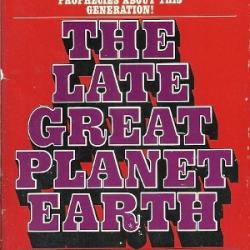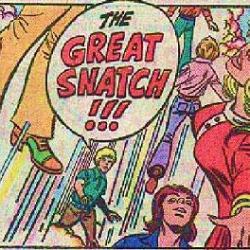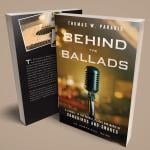Nicolae: The Rise of Antichrist, Chapter 3
Chapter 3 of Nicolae is terribly exciting, at least by the standards of these books. It’s quite eventful and almost even suspenseful in the authors’ trademark, solipsistic way of utterly disregarding the fate of everyone except for our heroes.
Rayford overhears Nicolae’s plan to obliterate dozens of cities with nuclear weapons, including Chicago — where his daughter and new son-in-law are. He races to warn Buck and Chloe to flee the city before its too late. All very thrilling, I suppose.
But I find I’m unable to engage any of that without first pausing a bit to point out that nothing in the next few chapters makes a lick of sense. Before we get bogged down in the details of Buck and Chloe’s escape from the Antichrist’s random, pointless campaign of destruction, I first need to step back to note that the Antichrist’s campaign of destruction is, in fact, random and pointless.
Utterly pointless. Inexplicably so.
Nicolae is fighting World War III against himself.
To account for this, let me step back even further — all the way back to 1970, the year Hal Lindsey published The Late Great Planet Earth.
Hal Lindsey was Tim LaHaye’s predecessor as the most popular exponent of End Times “Bible prophecy” pop-theology. TLGPE was one of the best-selling books of the 1970s, and he followed it up with other hugely popular and influential titles, such as There’s a New World Coming.
Lindsey re-popularized the premillennial dispensationalist prophecy scheme first popularized by the annotated Scofield Reference Bible. He studied that scheme at Dallas Theological Seminary, the Bible college that has long been the main institutional promoter of this Darby/Scofield mythology. Lindsey proved to have a knack for imagining strange applications and potential fulfillments of the “prophecies” he studied there, which gave his books a “ripped-from-the-headlines” sense of urgency.
But unlike Tim LaHaye, Lindsey was never also a member of the John Birch Society. He came to the PMD mythology without any other pre-existing mythology or ideology that he’d need to graft onto it. That meant, among other things, that Lindsey’s version of End Times mania caught on with hippies in a way that LaHaye’s Bircherized variation never could have.
Hal Lindsey begat Larry Norman. Tim LaHaye begat Kirk Cameron.
This also meant that Lindsey’s imagined Antichrist did not need to conform to the Bircher bogeymen of LaHaye’s political nightmares. Hal Lindsey was not obsessed with the United Nations. He feared a coming tyrannical one-world-government led by the Antichrist, but he assumed it would come about — based on his reading of Revelation 6 — as the work of a “conqueror bent on conquest” and as the result of the war represented by the apocalyptic rider on the red horse.
So Lindsey didn’t pay much attention to the powerless diplomatic peacemakers of the U.N. Instead, he cast a wary eye on what was then called the European Common Market — then a 10-nation entity that he feared would become the 10-horned Beast of Revelation.
Lindsey’s popularity faded in the 1980s, mainly because the world had stubbornly refused to end the way he insisted it should. But his later books, like The 1980s: Countdown to Armageddon, also clashed with the changing zeitgeist of his target audience. They had moved on to celebrate Ronald Reagan’s “morning in America.” (Optimism and premillennialism don’t get along well.) And by the 1980s, Lindsey’s efforts to cling to the outlines of his 1970s prophecies had grown strained. Europe was moving closer to union, but that effort now involved too many countries to correspond to any of the numerological schemes Lindsey had claimed.*
The end of the Cold War threw a wrench into the pop-apocalypse publishing business. Not only did it bring about an unfriendly sense of optimism, but it embarrassingly exposed the failure of decades of “Bible prophecy” warnings about a Soviet Antichrist.
Within a few years, however, two factors suggested that End Times mania was poised for a big rebound: There was a Democrat in the White House, and the calendar showed that a new millennium was approaching.
LaHaye recognized what that meant, seized the opportunity, and cashed in.
LaHaye also brought something new to the equation: the dark political mythology of his John Birch Society roots. Lindsey’s repackaged Scofieldism lacked any coherent political vision. If you believed Lindsey’s books, there was nothing you had to do except grow out your hair, strum a guitar, and wait for Jesus. But Tim LaHaye didn’t just give you a list of prophecies, he also provided a list of enemies (including, ironically, the same long-haired hippy freaks who once embraced Lindsey’s books). LaHaye’s pop-theology comes with a political agenda.
One consequence of that has been the “tea party movement” — a rebranded, 21st-century reincarnation of LaHaye’s beloved John Birch Society. LaHaye’s contribution to the tea party hasn’t been much noted, with most of the credit/blame focused on the funders and hands-on orchestrators of the astroturf “movement.” But no amount of astroturf and agitation can work for long unless it finds a receptive audience, and I think Tim LaHaye — as much as anyone except for perhaps Fox News — helped to prepare that audience.
Am I suggesting that LaHaye’s selling 60 million books of Bircher propaganda from 1995 to 2005 might have something to do with the resurgence of Bircher ideology in the following years? Well, I think that question pretty much answers itself.
LaHaye’s hybrid of Scofieldism and Bircherism also created another problem, because the two mythologies don’t always fit together neatly. This is a problem that poor Jerry Jenkins isn’t able to fix. And it means that the hybrid story LaHaye wants to tell in these books sometimes just doesn’t work.
Here, in Chapter 3 of Nicolae, the seams are showing. We can see the gap between the Bircher ideology of a diabolical conspiracy of U.N. peaceniks and the pre-existing PMD narrative of a warrior Antichrist. Jenkins is unable to bridge that gap.
The two strained strains of LaHaye’s hybrid story have come together here to bring us two things:
1. An authoritarian one-world government that enjoys universal support and acclaim.
2. World War III.
Those two things simply cannot exist at the same time. Jenkins does his best to dismiss or diminish the contradiction, or at least to distract us from it, but there it is. If all the world is now a single, unified entity, with a single government retaining an exclusive monopoly on force and weaponry, then there’s just no way to also have World War III.
There’s no one else to have a war with or to war against.**
Thus we have this odd “war” described here in Nicolae — a one-sided conflict that consists of Global Community forces bombing random cities for no apparent reason.
That’s not a war, just militarized murder. And it’s not a “world” war, either, since the bombing turns out to be confined to North America, Britain and Egypt. I’m guessing the first two are targets due to this book being written in English for an English-speaking audience (but what about Australia?). And Egypt, I guess, was probably added due to some “Bible prophecy” reference I don’t quite follow. (I know it’s not anything from Revelation or Daniel, but passages declaring judgment against Egypt aren’t hard to find throughout the Bible.)
This arbitrary bombing will be excused and explained as retaliation against the short-lived insurrection in those countries — the one involving the former U.S. president and the “East Coast militias.” As far as I can tell, though, that rebellion has already been extinguished before Nicolae starts his massive bombing campaign in earnest.
Jenkins explicitly describes the insurrection as Nicolae’s pretext — his false pretext — for this campaign, but he never indicates what the Antichrist’s real motive is. Nicolae does not benefit from this mass-slaughter. He doesn’t use it as a means toward some end, some goal or objective he wants to achieve. Jenkins just shows him, rather, as killing millions of people and destroying dozens of cities because he can, and because he enjoys it.
In one sense I suppose that’s fair enough. The Antichrist is supposed to be the embodiment of ultimate evil, but up to now he’s been fairly harmless, so perhaps a bit of capricious, cackling mass-murder would help to establish his super-evil credibility. But it’s still just random and absurd.
In creating their Antichrist character, the authors don’t seem to have given much thought to the meaning of evil or to the meaning of that word, Anti-Christ. Random, senseless killing surely qualifies as some kind of evil, of course, but it’s quite rare. The perpetrators of apparently random and senseless violence are almost always acting according to their own twisted logic. They want something, and they somehow imagine that this violence will let them get it.
That’s how most evil works. It has some goal, some desire. It wants something — maybe even a good thing — and it won’t stop at anything in order to get it.
That suggests two possible directions for an Anti-Christ character. He could be portrayed as someone who wants the opposite of what Christ wants. Or he could be portrayed as wanting the same thing as Christ, but seeking to attain it through opposite means.
Either way, one could not write such a character without first trying to understand what Christ wants and how Christ seeks to attain it. Thus, again, the authors have given us a shallow and arbitrary picture of the Antichrist because he’s the mirror-image of their shallow and arbitrary picture of Christ.
Nicolae’s one-sided pretend “war” of random bombings targeting his own cities also makes me want to file some kind of legal appeal in the courts of prophecy. There are supposed to be rules about such things. Prophecies must be fulfilled. But we’re now two seals into the judgments allegedly prophesied in Revelation, and by my count the authors are 0-for-2.
Horseman No. 1, the first seal, is supposed to ride forth as a conqueror bent on conquest. But Nicolae Carpathia never rode forth or conquered anything. He became global dictator by unanimous acclaim without firing a shot. (Well, he fired one shot, through Stonagal and into his buddy, but that wasn’t part of his conquest. If anything, that shooting interfered with it — causing the delay and muddling of his big OWG announcement.)
Nicolae may be the perfect incarnation of the U.N. peacenik Antichrist imagined by the John Birch Society, but such a figure cannot claim to fulfill the “Bible prophecy” of Revelation 6.
And no, this new bombing campaign can’t count as his “conquest.” He’s bombing people who had already submitted to him and embraced his reign. Every bomb he drops is on a loyal city that’s already flying the flag of the Global Community. That’s sadistic, but it’s not “conquest.”
And neither is it “war.” A one-sided nuclear killing spree isn’t war, just mass-murder by military means. The rider on the red horse is an impostor, and thus a second “prophecy” is going unfulfilled.
I’m not sure what the rules are for failures to fulfill required prophecies. How many mulligans does this apocalypse get before some sort of reset or restart has to kick in?
The guy I feel sorry for here is Famine. There he is with his scales, sitting on his black horse, all ready to go. But then the first two riders muff his entry cue.
And now everything backstage in Heaven is all mixed up. Famine’s all, like, “Should I just go?” And the living creature is like, “No, you don’t ride until I say, ‘Come!'” And Famine goes, “Well then say it already.” And the living creature is all, “Not until the Lamb opens the seal.” And the Lamb is like, “Hold your horses, you two. I’m waiting to see some conquest and war before I open any more of these.” But then there’s still no conquest and war, just a lot of random bombing for no reason. …
It’s just a heavenly mess.
– – – – – – – – – – – –
* I think Lindsey would have been wise to have learned from his old mentor, John Walvoord, who sold 1.5 million copies of his 1973 book Armageddon, Oil and the Middle East Crisis, then later sold millions more of the same book in 1991, after a search-and-replace update now identifying Saddam Hussein as the Antichrist.
The “Bible prophecy” Rapture Ready website has an unintentionally amusing description of this in its tribute page for Walvoord:
It is interesting to note that the revision of the book, Armageddon, Oil and the Middle East Crisis was mainly due to the rapidly changing global landscape. The first edition quickly became outdated as the prophetic timeline continued to advance. Some of the topical additions made in the revision include: Changing Alignment of Europe and the End of the Cold War, Revival of Roman Empire, Camp David Accords, Invasion of Lebanon, New Islamic Republic of Iran, Saddam Hussein Seizes Power in Iraq, Iraq’s move to absorb Kuwait, and so much more. I am sure that, were Walvoord still alive, he would be ready to revise once again!
I am sure he would be. If there’s one thing “Bible prophecy scholars” know how to do, it’s revise their claims “due to the rapidly changing global landscape.”
** Well, there’s Israel, I suppose — the one nation that has inexplicably retained its sovereignty, left out of Nicolae’s almost-one-world government. But Israel was only excluded from that global federation because LaHaye’s variant of the PMD check list requires Israel to sign a peace treaty with the Antichrist.
Unfortunately for LaHaye and Jenkins, that peace treaty is “prophesied” to be honored for three and a half years, and the Red Horseman has to bring World War III before that, so Israel cannot be the opponent in the Antichrist’s lonely world war.
Suppose they prophesied a war and no one came?












